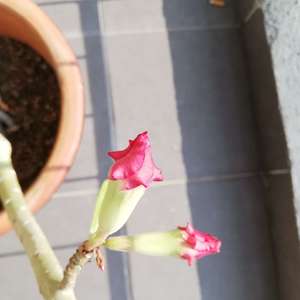成长记
Edgar Enrique Solis de la Rosa
2018年10月29日

I Nuevo agregado un Adenium arabicum en mi jardín


0
0
文章
Miss Chen
2018年09月08日

Adenium obesum, commonly called desert rose, stands out among other desert plants with its trumpet-shaped flowers and gray, elephantine trunk. It adds a splash of color and visual interest to low-water gardens where few other flowering shrubs thrive. Desert rose requires minimal upkeep and care. The plant must be grown under the right conditions and provided with care early on so it thrives.
Climate and Temperature

Desert rose comes from the arid climates of eastern Africa and the Arabian peninsula. As a result, it tolerates extreme heat well and is intolerant of cold weather. Desert rose performs best in U.S. Department of Agriculture plant hardiness zones 10a through 12, where temperatures stay reliably above 33 degrees Fahrenheit. In warmer climates, desert rose blooms and retains its leathery, dark green foliage year-round, but it may enter dormancy if nighttime temperatures dip below 40 F or if daytime temperatures stay below 64 F. Cover outdoor plants if cold weather if forecast and move potted desert roses indoors, if possible.
Sunlight and Soil

Full sun and fast-draining soil are key to successfully growing a desert rose. An unshaded south-facing bed with at least 4 square feet of space is best for garden growing, although the soil must be porous with a moderate nutrient content. Grow desert rose in a container in marginal areas where winter cold snaps are common. Repot the plant every two years into a shallow, slightly larger pot to force vertical growth and show off the plant's unusual swollen trunk. Use a mixture of standard potting soil amended with one-third coarse sand to strike the right balance between nutrient content and drainage. Use a pot with drainage holes.
Seasonal Watering

The watering needs of a desert rose vary significantly throughout the year. Water weekly during the late spring and summer, providing roughly 1 inch of water each time. Increase water by one-half during especially hot or windy weather to prevent dehydration, but always allow the soil to dry out completely between waterings to prevent root rot. The plant needs little to no supplemental water during autumn and winter, especially in years with normal rainfall. Only provide water during the colder months if no rain falls for longer than two weeks. For a pot-grown desert rose, provide just enough water during the winter to keep it from shriveling.
Nutrient Needs

The desert rose is an efficient feeder and it doesn't generally need fertilizer. Its nutrient needs vary according to age and growing conditions. Most desert rose plants grow quickly during their first three to five years and will quickly exhaust the nutrient supply of their soil if it isn't supplemented. A pot-grown desert rose may have a similar issue, although it is ongoing throughout its life. Dissolve 1/4 teaspoon of 15-15-15 or 7-9-5 ratio fertilizer in 1 gallon of water. Water the plant with the mixture every two weeks. Apply the fertilizer solution only during the spring and summer, and always apply it to moist soil to prevent root burn.
Toxic Sap

Desert rose has a few drawbacks. The most significant consideration to make before growing it in your garden is the potential danger of the toxic sap. Desert rose exudes a watery, slightly sticky sap from its leaves, stems and flowers when it is pruned or damaged. The sap contains glycosides that can cause an irregular heartbeat or possibly kill someone who eats parts of the plant. People and pets are both affected by the toxic elements in desert rose sap, so don't grow the plant where curious children or pets play.
Climate and Temperature

Desert rose comes from the arid climates of eastern Africa and the Arabian peninsula. As a result, it tolerates extreme heat well and is intolerant of cold weather. Desert rose performs best in U.S. Department of Agriculture plant hardiness zones 10a through 12, where temperatures stay reliably above 33 degrees Fahrenheit. In warmer climates, desert rose blooms and retains its leathery, dark green foliage year-round, but it may enter dormancy if nighttime temperatures dip below 40 F or if daytime temperatures stay below 64 F. Cover outdoor plants if cold weather if forecast and move potted desert roses indoors, if possible.
Sunlight and Soil

Full sun and fast-draining soil are key to successfully growing a desert rose. An unshaded south-facing bed with at least 4 square feet of space is best for garden growing, although the soil must be porous with a moderate nutrient content. Grow desert rose in a container in marginal areas where winter cold snaps are common. Repot the plant every two years into a shallow, slightly larger pot to force vertical growth and show off the plant's unusual swollen trunk. Use a mixture of standard potting soil amended with one-third coarse sand to strike the right balance between nutrient content and drainage. Use a pot with drainage holes.
Seasonal Watering

The watering needs of a desert rose vary significantly throughout the year. Water weekly during the late spring and summer, providing roughly 1 inch of water each time. Increase water by one-half during especially hot or windy weather to prevent dehydration, but always allow the soil to dry out completely between waterings to prevent root rot. The plant needs little to no supplemental water during autumn and winter, especially in years with normal rainfall. Only provide water during the colder months if no rain falls for longer than two weeks. For a pot-grown desert rose, provide just enough water during the winter to keep it from shriveling.
Nutrient Needs

The desert rose is an efficient feeder and it doesn't generally need fertilizer. Its nutrient needs vary according to age and growing conditions. Most desert rose plants grow quickly during their first three to five years and will quickly exhaust the nutrient supply of their soil if it isn't supplemented. A pot-grown desert rose may have a similar issue, although it is ongoing throughout its life. Dissolve 1/4 teaspoon of 15-15-15 or 7-9-5 ratio fertilizer in 1 gallon of water. Water the plant with the mixture every two weeks. Apply the fertilizer solution only during the spring and summer, and always apply it to moist soil to prevent root burn.
Toxic Sap

Desert rose has a few drawbacks. The most significant consideration to make before growing it in your garden is the potential danger of the toxic sap. Desert rose exudes a watery, slightly sticky sap from its leaves, stems and flowers when it is pruned or damaged. The sap contains glycosides that can cause an irregular heartbeat or possibly kill someone who eats parts of the plant. People and pets are both affected by the toxic elements in desert rose sap, so don't grow the plant where curious children or pets play.
0
0
























